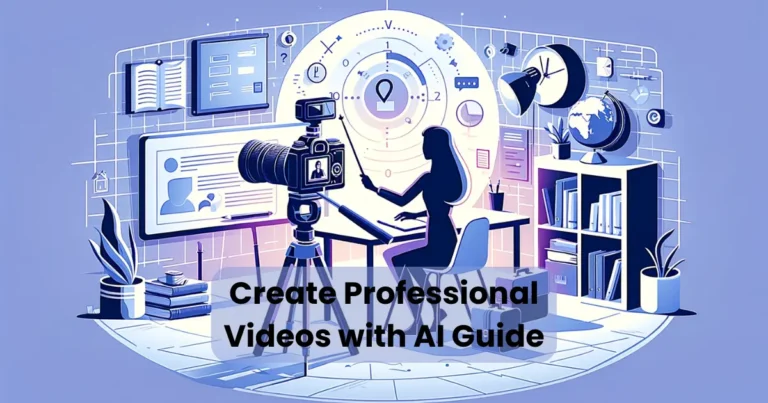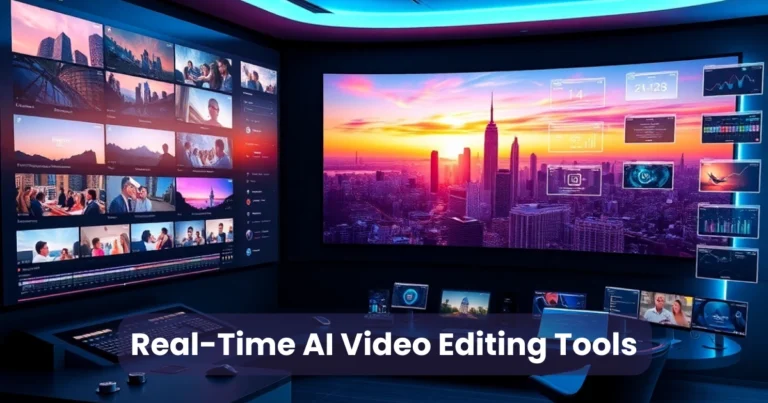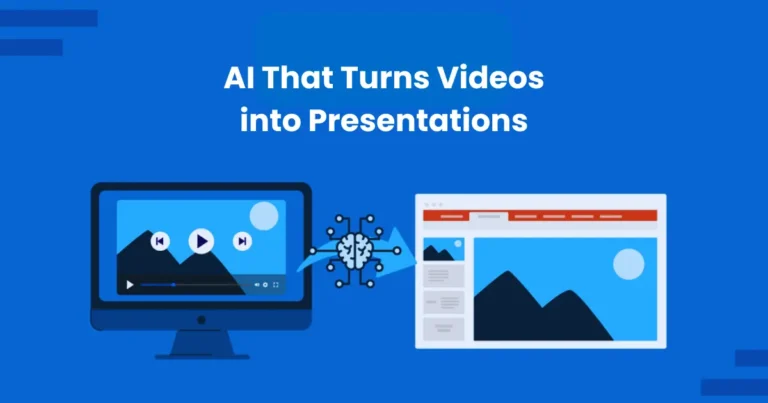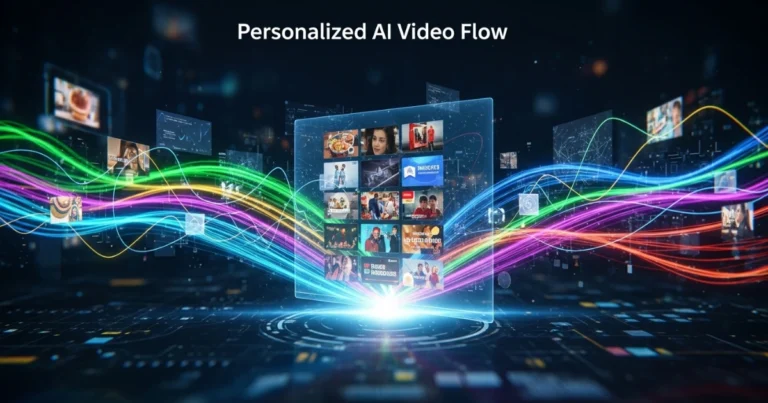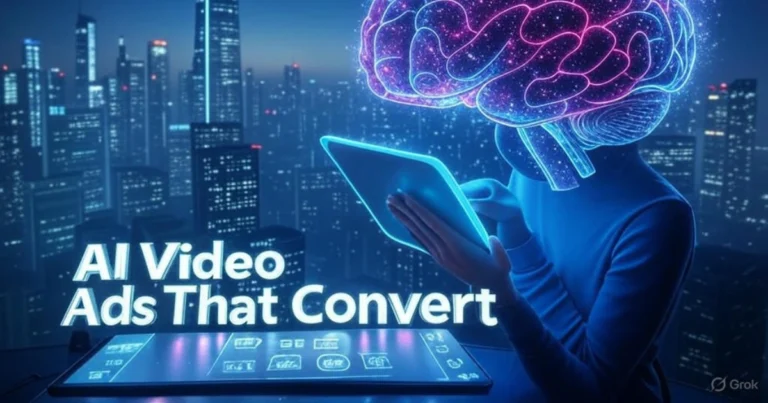How AI Understands and Generates Video Content
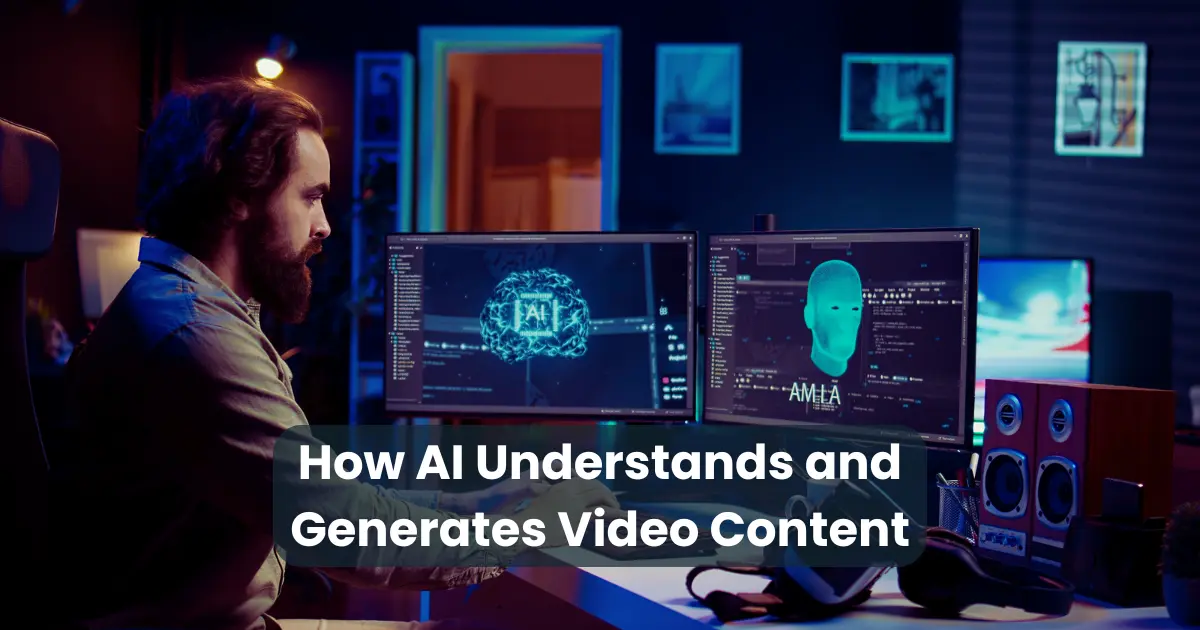
Contents
In an age where video dominates digital communication, learning how AI understands and generates video content is more important than ever. Artificial intelligence no longer just analyzes video data it also creates compelling visual stories from scratch. From social media marketing to advanced filmmaking, AI is transforming the entire video production pipeline. By recognizing patterns, interpreting motion, and generating realistic visuals, AI brings automation and innovation to a whole new level. As this technology evolves, it continues to reshape how we create, consume, and interact with video content across platforms.
What Is AI Video Processing?
AI video processing is the use of artificial intelligence to analyze, interpret, enhance, and even create video content. It combines multiple technologies such as computer vision, machine learning, and deep neural networks to understand both the visual and audio elements in a video.
Instead of manually reviewing hours of footage, AI can automatically detect objects, track motion, classify scenes, and recognize actions in real time. This not only speeds up the workflow but also improves accuracy.
Moreover, AI doesn’t just assist with analysis it also plays a growing role in content creation. Using advanced models, it can generate animations, enhance video resolution, and even convert text into full video clips. As a result, AI video processing bridges the gap between automation and creativity, enabling faster and smarter video production across industries.
How AI Understands Video Content
To fully grasp how AI understands and generates video content, we first need to explore how it interprets visual data. AI uses complex algorithms to break down video into understandable parts frames, objects, movements, and sounds. This process involves several advanced techniques:

Object Detection
AI begins by identifying and labeling objects within each frame. Using deep learning models like YOLO (You Only Look Once) or Faster R-CNN, the system can detect people, vehicles, animals, and more. These models analyze pixel patterns and assign confidence scores to determine what the object likely is.
This ability is essential for tasks like surveillance, content moderation, and scene tagging in media platforms.
Scene Segmentation
Next, AI segments videos into meaningful scenes by analyzing changes in lighting, background, and motion. It recognizes when one shot ends and another begins much like how a human editor would. This is crucial for organizing large video libraries and generating automatic summaries or previews.
Scene segmentation also helps AI understand context, which influences how it analyzes emotional tone or storyline flow.
Action Recognition
One of the most advanced capabilities is recognizing actions within a video. AI studies sequences of frames to detect movements like walking, waving, or jumping. This process, known as temporal analysis, uses Recurrent Neural Networks (RNNs) or 3D Convolutional Neural Networks (3D-CNNs) to interpret movement over time.
As a result, action recognition powers applications in sports analytics, security monitoring, and video search engines.
By combining these techniques, AI can extract deep insights from video footage. This layered understanding lays the foundation for the second half of the equation: how AI understands and generates video content seamlessly.
Data Sources and Machine Learning Models
To understand how AI understands and generates video content, it’s essential to explore the data and models that power these capabilities. AI does not function in a vacuum—it learns from vast datasets and evolves through carefully designed machine learning architectures.

Training Data Sources
AI requires large and diverse video datasets to learn how to analyze and recreate content accurately. These datasets include labeled examples of actions, objects, environments, and even emotions. Some widely used datasets include:
- Kinetics-700 – Features hundreds of human action classes from YouTube clips.
- YouTube-8M – Contains millions of videos annotated with labels for real-world scenarios.
- AVA (Atomic Visual Actions) – Focuses on action recognition with frame-level annotations.
- ActivityNet – Supports understanding of complex events in untrimmed video clips.
These datasets serve as the foundation for training AI to understand scene changes, detect motion, and replicate human-like creativity.
Core Machine Learning Models
To process this data, AI systems use a combination of advanced models:
- Convolutional Neural Networks (CNNs) – These extract spatial features from video frames, helping the AI detect objects and visual patterns.
- Recurrent Neural Networks (RNNs) and Long Short-Term Memory (LSTM) networks – These handle temporal data, allowing AI to understand sequences, movements, and context across time.
- 3D Convolutional Networks – Extend CNNs to three dimensions, enabling spatial-temporal analysis for motion recognition.
- Transformers – Initially used in natural language processing, transformers now help AI understand and generate long-form video content by modeling dependencies across frames.
Each of these models contributes to a deeper and more nuanced comprehension of video data, enabling highly accurate recognition and generation processes.
In short, the combination of high-quality data and advanced learning models makes it possible for AI to master how AI understands and generates video content—paving the way for applications that are both practical and creative.
How AI Generates Video Content
Now that we’ve covered how AI interprets visual information, it’s time to explore the second half of the process: how AI generates video content. Using deep learning and generative models, AI systems can create videos from images, text, and even audio input. This ability is revolutionizing industries such as advertising, filmmaking, gaming, and education.

1. Generative Adversarial Networks (GANs)
At the heart of AI-generated videos are Generative Adversarial Networks (GANs). GANs consist of two neural networks: a generator and a discriminator. The generator creates synthetic video frames, while the discriminator evaluates their realism. Over time, the generator improves, producing content that is almost indistinguishable from real footage.
These networks can generate human faces, natural environments, and even simulate lighting and camera angles.
2. Text-to-Video Generation
Another exciting area of progress is text-to-video generation. Here, AI systems take written prompts and convert them into visual stories. For example, you can type “a cat jumping on a table,” and the AI will render a realistic video matching that scene.
This is possible thanks to models like Meta’s Make-A-Video, Google’s Imagen Video, and Runway’s Gen-2, which combine natural language processing (NLP) and video synthesis.
3. Motion Transfer and Animation
AI can also animate static images using motion transfer techniques. By analyzing the motion from a source video, AI applies it to a target image or character, making it appear as if the subject is moving or speaking. This is especially useful in gaming, AR/VR, and creating deepfakes (when used ethically).
4. Frame Prediction and Inpainting
To generate smoother sequences, AI uses frame prediction—a technique that predicts future frames in a video. It also applies inpainting to fill in missing parts of damaged or incomplete footage. These features are invaluable in video restoration and real-time editing.
Thanks to these innovations, the way we understand how AI understands and generates video content has drastically shifted. What once took teams of professionals now requires only smart models and quality input.
Real-World Applications
Understanding how AI understands and generates video content becomes even more impactful when we look at its real-world applications. From entertainment to healthcare, AI is reshaping how video is used across industries. Let’s explore the key areas where this technology is already making a difference.
1. Video Editing and Post-Production
AI tools like Adobe Sensei and Runway streamline video editing by automating time-consuming tasks such as background removal, color correction, and scene detection. Editors can now produce professional-quality content faster, thanks to AI’s deep understanding of video structure and motion.
2. Content Creation for Marketing
Marketers increasingly use AI to generate promotional videos based on product descriptions, customer reviews, or even blog posts. These tools cut production costs and enable rapid content creation, helping brands maintain a consistent online presence.
3. Personalized Recommendations
Streaming platforms like Netflix and YouTube use AI to analyze viewer behavior and video content in real-time. By understanding what’s inside a video—its genre, mood, and pace—AI suggests content that matches each user’s preferences, improving engagement and retention.
4. Virtual Influencers and Avatars
With AI-generated video content, brands now create virtual influencers and avatars that interact with users in real time. These digital personas are powered by motion synthesis and voice generation, offering new ways to connect with audiences, especially in gaming and social media.
5. Surveillance and Security
In surveillance, AI monitors real-time footage to detect unusual activity, identify faces, and recognize license plates. Its ability to quickly understand and respond to visual information enhances safety in public and private spaces.
6. Education and E-Learning
Educators use AI-generated videos to turn complex topics into engaging visual content. Platforms like Synthesia and Pictory allow teachers to create lessons from scripts, complete with animated characters and voiceovers, without traditional filming.
These practical uses highlight the power of knowing how AI understands and generates video content. As adoption grows, we’ll continue to see even more dynamic, responsive, and intelligent video tools across every sector.
Benefits of AI in Video Generation
Exploring how AI understands and generates video content reveals a wide range of powerful benefits. These advantages are not only transforming creative industries but also improving productivity, reducing costs, and enabling new forms of storytelling. Below are the top benefits of using AI in video generation:

1. Speed and Efficiency
AI accelerates the video production process dramatically. What once took days or weeks—such as editing, rendering, or creating motion graphics—can now be done in minutes. Automation of repetitive tasks allows creators to focus on strategy and creativity.
2. Cost Reduction
By automating labor-intensive tasks like scene composition, voice dubbing, and animation, AI significantly lowers production expenses. Small businesses and independent creators now have access to high-quality video tools without needing large budgets.
3. Scalability of Content Creation
AI enables mass production of personalized videos at scale. Marketers can easily generate hundreds of customized ads for different audiences using one script. Similarly, educational platforms can quickly create tailored lessons for learners worldwide.
4. Accessibility and Democratization
One major benefit of understanding how AI understands and generates video content is that it makes video creation accessible to non-experts. With intuitive platforms, users don’t need advanced technical or design skills to produce professional-looking videos.
5. Enhanced Creativity
AI doesn’t replace creativity—it enhances it. Creators can use AI as a collaborative tool for ideation, style inspiration, and automation of technical steps. This frees up mental space for storytelling, innovation, and experimentation.
6. Real-Time Editing and Personalization
With AI-powered tools, real-time editing is now possible. Whether it’s applying live effects, translating subtitles, or adjusting facial expressions, creators can make quick changes on the fly—something that was previously time-consuming and manual.
These benefits showcase why understanding how AI understands and generates video content is crucial for modern creators and businesses. As AI continues to evolve, these advantages will only become more impactful and widespread.
Challenges and Limitations
While the advantages of AI are significant, it’s equally important to recognize the challenges that come with understanding how AI understands and generates video content. These limitations remind us that AI is a tool—powerful but imperfect—and must be used with caution and responsibility.

1. Data Dependency
AI systems rely heavily on large, high-quality datasets. If the data used for training is biased, incomplete, or low-quality, the generated video content will reflect those flaws. Poor data can lead to inaccuracies, offensive outputs, or unrealistic results.
2. Ethical and Legal Concerns
One of the most pressing issues in AI video generation is the rise of deepfakes and misinformation. Generating lifelike videos without consent raises ethical red flags and legal questions, particularly around identity theft, political propaganda, and digital manipulation.
3. High Computational Costs
Despite being faster than traditional methods, video generation with AI still requires significant computing power, especially during training phases. This creates a barrier for individuals and organizations without access to high-end GPUs or cloud infrastructure.
4. Lack of Creative Intuition
Although AI can replicate styles and generate content, it lacks genuine human creativity and intuition. It can’t truly understand emotional context, abstract storytelling, or cultural nuance in the way human creators do. This limits its use in high-artistic endeavors.
5. Limited Context Awareness
AI models often struggle with long-term context in videos. While they can analyze and generate short clips effectively, maintaining narrative consistency over extended durations remains a challenge.
6. Risk of Job Displacement
As businesses adopt AI tools for video production, there’s a growing concern about job loss in creative industries. While AI can be collaborative, it may also replace certain roles traditionally handled by editors, animators, or scriptwriters.
Despite these limitations, the understanding of how AI understands and generates video content continues to evolve. Developers and researchers are actively working to address these issues, aiming for more ethical, efficient, and inclusive AI technologies.
Future of AI-Generated Video Content
As we look ahead, the future of how AI understands and generates video content is full of promise. With rapid advancements in machine learning, neural networks, and data processing, AI is set to play an even bigger role in reshaping how we produce and consume video content.

1. Hyper-Realistic Generation
AI-generated videos will continue to improve in visual fidelity. We can expect near-perfect simulations of human expressions, movements, and real-world environments. These enhancements will make it harder to distinguish between real and synthetic content.
2. Real-Time Content Creation
Soon, AI will be able to generate high-quality video content in real time based on live inputs. This opens up endless opportunities in streaming, virtual events, and interactive gaming—where the content adapts dynamically to the user’s actions or preferences.
3. Seamless Multimodal Integration
AI models will increasingly combine text, image, voice, and video into unified outputs. This means users can describe an entire scene in words, and the AI will generate matching video complete with voices, music, and visual effects.
4. Creative Collaboration Between Humans and AI
Rather than replacing humans, the future will focus on collaborative creativity. AI will assist filmmakers, marketers, educators, and developers by handling technical tasks, allowing them to focus on storytelling and emotional engagement.
5. Regulatory and Ethical Advances
As AI’s role in media deepens, governments and organizations will establish clearer regulations to prevent misuse. Ethical frameworks will be developed to ensure transparency, consent, and authenticity in AI-generated videos.
6. Personalized Media Experiences
One of the most exciting prospects is ultra-personalized video content. Imagine films that adapt to your mood, news summaries tailored to your interests, or educational videos that respond to your learning pace—all made possible by a deeper understanding of how AI understands and generates video content.
AI-generated video content is not just a trend; it’s the next evolution of digital storytelling. As long as creators, technologists, and policymakers collaborate, the future holds transformative potential.
Conclusion
In summary, understanding how AI understands and generates video content is key to unlocking the full potential of this groundbreaking technology. From data analysis to generative models, AI is transforming the way videos are created, personalized, and consumed across various industries.
While challenges like ethical concerns and computational demands remain, the benefits of speed, scalability, and creativity make AI an indispensable tool for modern content creators. As AI technology advances, we can expect even more immersive and interactive video experiences tailored to individual preferences.
By staying informed about how AI understands and generates video content, businesses and creators can harness these innovations responsibly and effectively, shaping the future of digital media.

